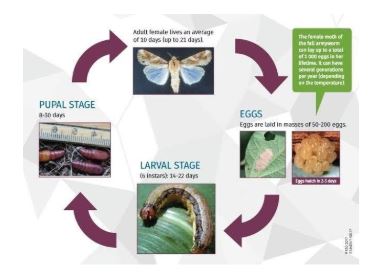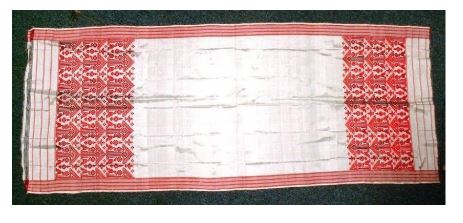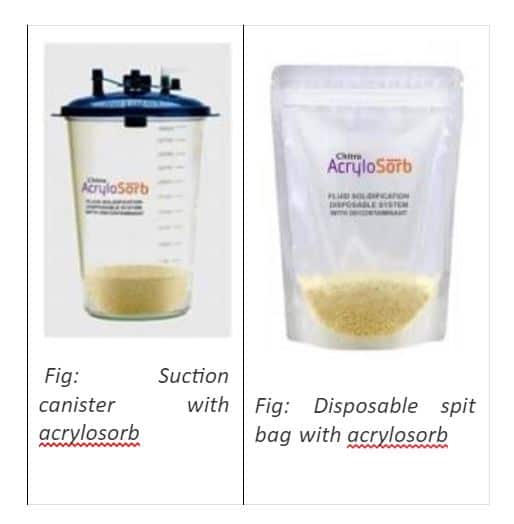IASbaba's Daily Current Affairs Analysis
IAS UPSC Prelims and Mains Exam – 11th April 2020
Archives
(PRELIMS + MAINS FOCUS)
Fall Armyworm attack the standing crops in Assam
Part of: GS Prelims and GS-III – Environment
In News:
- Fall armyworm attack on the standing crops in various districts of Assam has been reported recently.
Important value additions:
Fall armyworm
- Fall Armyworm (Spodoptera frugiperda) is an insect.
- It is widely distributed in Eastern and Central North America and in South America.
- It has spread across the world because of trade and its strong flying ability.
- India’s tropical climate could allow the pest to thrive and spread further.
- If not well managed, it can cause significant damage to crops in its larva stage .
- It can affect large variety of species of crops, primarily maize.
- It can be controlled with:
- insecticides (like lambda-cyhalothrin)
- through natural predators (such as coccinellid beetles
- by inter-cropping.

Image source: Click here
Food grains to be provided to non-NFSA beneficiaries
Part of: GS Prelims and GS-II – Governance
In News:
- Food grains shall be provided to non-NFSA (National Food Security Act) beneficiaries with ration cards issued by State governments.
Key takeaways:
- Government of India has directed Food Corporation of India (FCI) to provide the beneficiaries with food grains at 5 Kg/person per month for 3 months at the rates of Rs. 21/Kg for wheat and Rs. 22/Kg for rice.
- It should be distributed uniformly across the country.
Important value additions:
National Food Security Act
- Government of India enacted the National Food Security Act, 2013 (NFSA).
- The Act covers upto 75% of the rural population and upto 50% of the urban population.
- The targeted population shall receive subsidized foodgrains under Targeted Public Distribution System, thus covering about two-thirds of the population.
- Ministry involved: Ministry of Consumer Affairs, Food & Public Distribution.
States asked to implement Market Intervention Scheme
Part of: GS Prelims and GS-III – Economy
In News:
- The Central government has directed all the States and Union Territories to implement the Market Intervention Scheme to ensure good prices for perishable crops.
Important value additions:
The Market Intervention Scheme (MIS)
- It is meant to protect the growers of perishable commodities from making distress sales, especially at times when prices fall below the cost of production.
- The scheme can be invoked by a State if it is willing to bear half the losses of procurement.
- The remaining loss is borne by the Centre, whenever there is a 10% fall in ruling market prices in comparison to the previous normal year.
- The Department of Agriculture and Cooperation implements the scheme.
- The Central Government implements MIS for a particular commodity on the request of a state government concerned.
Miscellaneous
Gamosas evolve as protective gear amidst COVID-19 pandemic
- Gamosas, a decorative cotton towel, are being used as protective gear to fight the coronavirus.
- The Gamosa/Gamusa is an article of great significance for the people of Assam.
- It is a white rectangular piece of cloth.
- It has a red border on three sides and red woven motifs on the fourth. Other colors may also be used.
- Cotton yarn is the most common material used for making/weaving gamosa.
- For special occasions, Pat silk is used.
- It is valued as a gift for visitors, a scarf, anti-dust mask, as a turban.

Image source: Click here
Chitra Acrylosorb Secretion Solidification system: Superabsorbent material for infected respiratory secretions
- Scientists at Sree Chitra Tirunal Institute for Medical Sciences and Technology (SCTIMST) have developed a super absorbent material titled Chitra Acrylosorb Secretion Solidification System.
- SCTIMST is an autonomous institute under the Department of Science and Technology (DST).
- The System is a highly efficient superabsorbent material for absorbing infected respiratory secretions.
- It can absorb liquids at least 20 times more than its dry weight.
- It also contains a decontaminant for in situ (at the site) disinfection.
- Containers filled with decontaminant will also immobilize the contaminated fluid by solidifying it (gel-like), thus avoiding spillage.
- The canister containing the solidified waste can be decomposed by incineration (destruction by burning).
- This technology reduces the risk for the hospital staff.
- It reduces the need for personnel for disinfecting and cleaning the bottles.
- Canisters can be reused.
- Disposal is safer and easier.

| Fig: Suction canister with acrylosorb | Fig: Disposable spit bag with acrylosorb |
Image source: Click here
(MAINS FOCUS)
ECONOMY/ GOVERNANCE
Topic: General Studies 2:
- Indian Economy and issues relating to planning, mobilization, of resources, growth, development and employment.
COVID-19: India needs an Emergency Basic Income
India announced 21-day lockdown to prevent the spread of COVID-19 and any exit from the lockdown is likely to be partial and provisional.
IMF economist Gita Gopinath has argued for a preservation of the economic system while the Great Lockdown lasts.
Do You Know?
- Singapore and Japan, which contained the disease spread initially, have re-introduced harsh lockdown measures to deal with a second wave of infections.
- The US announced a $2.2 trillion stimulus on a $20 trillion GDP base
- Malaysia has mobilised close to 18% of its GDP
Impact of lockdown
- Lockdown poses a unique challenge of keeping productive capacity intact. Nobel Prize-winning economist Paul Krugman termed this the coronacoma.
- Coronacoma is the economic equivalent of a medically induced coma, in which some brain functions are deliberately shut down to give the patient time to heal
What should be the economic response to the crisis?
The response should be two-fold
- One, an immediate disaster relief component to ensure survival of both firms and workers who have been rendered without work.
- Two, a stimulus component that aims to repair and restart production lines during the exit phase of the lockdown.
Challenges
- Weak response (Economically): The relief measures by Union & state governments appear to be grossly inadequate to meet the challenges
- Lack of resources: Emerging markets, such as India, don’t have the luxury of offering generous relief measures like developed countries
Examples of other emerging economies
- Thailand, whose per capita income (PPP) is a little more than two times that of India, has announced a package that is 10 times bigger (as a share of GDP) than India.
- Malaysia, whose per capita income (PPP) is four times that of India, has announced a package that is 16 times bigger (as a share of GDP) than India.
Alternative Suggested – EBI (Emergency Basic Income)
- EBI will be a generous, but provisional income transfer programme, which is unconditional and universal.
- EBI will be subjected to a rollback when normalcy returns
- It will be a programme with a fixed and transparent sunset clause (linked to new infections falling beyond a certain level, or economic growth rising above a certain threshold)
- Funding could be through special purpose vehicle as long as the Great Lockdown lasts
- Challenge with EBI: Implementation issues because everyone doesn’t have a functional bank account or access to mobile or internet (for e-transfers).
Way Forward
- EBI must also include an in-kind transfer component.
- The ratio of cash to in-kind transfers should be left for states to suit their unique needs
- Centre’s role should be to enable funding for this programme so that states can focus on its implementation.
Connecting the dots:
- Poverty lines –various methods to determine it
- JAM trinity- utility and challenges
AGRICULTURE/ GOVERNANCE
Topic: General Studies 2 & 3:
- Agricultural issues and Issues related to direct and indirect farm subsidies and minimum support price
- Indian Economy and issues relating to planning, mobilization, of resources, growth, development and employment.
Agricultural Distress
The COVID-19 crisis is affecting rural India especially at a time when agriculture is already in a distress situation.
Agricultural distress Causing Migration
- According to the 2011 census, 3.5 million migrants moved within the last one year due to economic reasons.
- The corresponding numbers for the 2001 and 1991 census, were, respectively, 2.2 and 1.4 million.
Do You Know?
- Majority of the migrant workers send 25 to 50 per cent of their monthly income to their families back home.
- In Bihar, these remittances accounted for 35.6 per cent of gross state domestic product in 2011-12, up from 11.6 per cent in 2004-05
Issues with Agricultural Sector
- Increasing Rural-Urban gap
- In 2008, the rural-urban gap was at 45% in terms of average revenue — versus 10% for China and Indonesia.
- The rural monthly per capita expenditure declined 8.8% from Rs 1,430 in 2011-12 to Rs 1,304 in 2017-18
- In 2013-2019, the average agricultural GDP growth rate (driven by livestock) was 3.1%, much lower than the average GDP growth rate — 6.7%
- The average growth of the crop sector, which accounts for two-thirds of the agricultural sector GDP, was 0.3 per cent.
- Declining Landholding Size
- Average landholding size of a household has shrunk to 1.1 ha in 2016 (Source: NABARD)
- A farm household needs to have at least 1 ha of land to make ends meet, whereas the proportion of those owning less than one ha is 82.8%
- 37% of farm households owned land parcels of smaller than 0.4 ha
- Another 30% of farm households holdings which between 0.41 and 1.0 ha.
- Only 13% agricultural households owned landholdings bigger than 2 ha.
- Irrigation has stagnated, with less than half of Indian farmland irrigated.
- Rural India suffers from “urban consumer bias”: Government has kept food prices very low to spare urban consumers of price rise
- Budget cuts have affected key agri-programmes such as the Rashtriya Krishi Vikas Yojana, the Backward Regions Grant Fund as well as irrigation schemes (Integrated Watershed Management Programme)
- Degradation in agricultural quality
- Rise of monocultures based on the intensive use of chemical pesticides has reduced soil productivity
- The level of water tables fell by 65 per cent in 10 years.
- Nearly 30 per cent of India’s land has been degraded due to deforestation, intensive farming, soil erosion and groundwater depletion.
- Increasing indebtedness of farmers
- Over half of the farmers are indebted
- The average loan amount outstanding for a farm household in India in 2017 was Rs 47,000.
- More than 3,20,000 farmers committed suicide between 1995 and 2016 (NCRB data)
- Rural Poverty
- NSS data show that rural poverty rose about 4 percentage points between 2011-12 and 2017-18 to 30 per cent
- Whereas urban poverty fell 5 percentage points over the same period to 9 per cent.
Way Forward
- The issue of migrant workers during the crisis should open the eyes of policy makers about the need to make agriculture sector a priority
- Agricultural sector should witness more investment to reduce the rural-urban gap
- Need for agro-ecological transition as it is more bio-diverse in nature, makes the system more resilient, strengthen food security and provide a safety net for farmers
Connecting the dots:
- Ashok Dalwai Committee on doubling of farmers’ income
- Zero Budget Natural Farming
- Second Green Revolution
(TEST YOUR KNOWLEDGE)
Model questions: (You can now post your answers in comment section)
Note:
- Correct answers of today’s questions will be provided in next day’s DNA section. Kindly refer to it and update your answers.
- Comments Up-voted by IASbaba are also the “correct answers”.
Q.1 The Gamosa/Gamusa is an article of great significance for the people of which of the following state?
- Arunachal Pradesh
- Assam
- Mizoram
- Nagaland
Q.2 Consider the following statements regarding Chitra Acrylosorb Secretion Solidification System:
- It has a superabsorbent material for absorbing infected respiratory secretions.
- Canister containing the solidified waste cannot be reused.
Which of the above is/are correct?
- 1 only
- 2 only
- Both 1 and 2
- Neither 1 nor 2
Q.3 Consider the following statements regarding fall armyworm:
- It is native to Africa.
- It can cause significant damage to cropsn when it is in its pupil stage.
Which of the above is/are correct?
- 1 only
- 2 only
- Both 1 and 2
- Neither 1 nor 2
Q.4 Consider the following statements:
- Food grains shall be provided to non-NFSA beneficiaries with ration cards only.
- They shall receive the benefit of food grains at subsidised rates for five months.
Which of the above is/are correct?
- 1 only
- 2 only
- Both 1 and 2
- Neither 1 nor 2
Q.5 Consider the following statements regarding Market Intervention Scheme:
- It is meant to protect the growers of perishable commodities
- The state bears half the loss of procurement.
Which of the above is/are correct?
- 1 only
- 2 only
- Both 1 and 2
- Neither 1 nor 2
ANSWERS FOR 10th April 2020 TEST YOUR KNOWLEDGE (TYK)
| 1 | A |
| 2 | C |
| 3 | B |
| 4 | C |
Must Read
About COVID-19 battle:
About economy after lockdown:
















